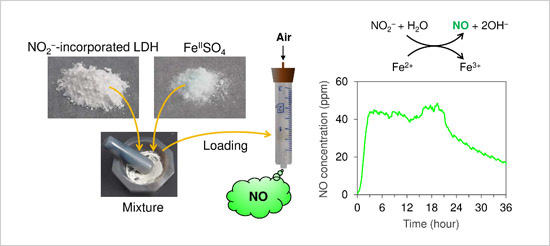 Press Release 2021
Press Release 2021
Development of a Portable and Disposable Nitric Oxide (NO) Generator
—Device May Be Used in the First-Aid Treatment of Acute Respiratory Failure Caused by Pulmonary Hypertension, Infection and Wounds—
NIMS has developed a disposable nitric oxide (NO) generator capable of supplying NO—a gas used to alleviate respiratory failure—at a stable rate for more than 12 hours.
“Disposable Nitric Oxide Generator Based on a Structurally Deformed Nitrite-Type Layered Double Hydroxide”
Shinsuke Ishihara, Takeshi Machino, Kenzo Deguchi, Shinobu Ohki, Yuuki Mogami, Masataka Tansho,Tadashi Shimizu, Jonathan P. Hill, Yusuke Yamauchi, and Nobuo Iyi ;
Journal: Inorganic Chemistry [April 16, 2021];
DOI : 10.1021/acs.inorgchem.1c00456)

figure. A novel NO generator
Abstract
Inhalation of low concentrations of NO causes human pulmonary blood vessels to dilate, increasing the lungs’ oxygen intake capacities. Because of this physiologically beneficial effect, NO has been used to treat newborns with pulmonary hypertension-induced hypoxic respiratory failure and patients with pulmonary hypertension caused by heart surgery. In addition, inhalation of NO is known to have anti-inflammatory, antithrombotic and antiviral effects. Its medical use to treat infectious pneumonia, including that caused by COVID-19, is therefore attracting a great deal of interest. The current NO inhalation method requires the use of large and expensive equipment, such as a compressed gas cylinder, limiting its usability. In 2020, this research team reported the development of a clay mineral material called layered double hydroxide (LDH) which is capable of releasing NO. This study demonstrated that LDH may be used to develop a smaller and cheaper NO supply device. However, a prototype LDH device was unable to generate NO for more than one or two hours and the concentration of NO released was unstable. Furthermore, due to the complex processes involved in synthesizing the LDH, which requires the integration of nitrite ions (NO2−) as an NO source, mass production proved challenging.
This research team recently succeeded in synthesizing a large amount of NO2−-incorporated LDH using only cheap, commercially available materials and water by adding a thermal treatment step to the synthetic procedure. The team then found that the structural deformation of the LDH caused by the thermal treatment had moderately slowed the chemical reactions occurring within it, causing it to release NO at a stable rate. A mixture of NO2−-incorporated LDH and iron(II) sulfate (FeⅡSO4) can be stored in a plastic column for a long period of time. When moist air is introduced into the column, NO2− is slowly reduced by ferrous iron (Fe2+), releasing NO. The amount of NO released and the rate at which it is released can be regulated by changing the composition and amount of the mixture. Only 1 g of NO2−-incorporated LDH is able to generate a medically effective concentration of NO (40 ppm, 250 ml/min) for more than 12 hours. Therefore, replacing the column once a day will allow a continuous supply of NO.
Respiratory failure is life-threatening, and delayed treatment of it may aggravate the condition and cause aftereffects. The team is hoping to put this portable and easy-to-use NO generator into practical use. Widespread use of this NO generator may help to treat many people suffering from respiratory conditions, such as newborns with pulmonary hypertension in developing countries and people with acute respiratory failure caused by wounds, burns, drowning, infections and other factors.
This project was carried out by a research team led by Shinsuke Ishihara (Principal Researcher, Frontier Molecules Group (FMG), International Center for Materials Nanoarchitectonics (MANA), NIMS) and Nobuo Iyi (Special Researcher, FMG, MANA, NIMS). This work was supported by Japan Agency for Medical Research and Development (AMED) and Tsukuba Clinical Research & Development Organization (TCReDO).
This research was published in the online version of Inorganic Chemistry, a journal of the American Chemical Society, as an “ASAP article” for the “Renaissance in NO chemistry” forum issue, on April 16, 2021.
(Regarding this research)
Shinsuke Ishihara
Principle Researcher,
Frontier Molecules Group,, MANA, NIMS
Tel:+81-29-860-4602
E-Mail:ISHIHARA.Shinsuke=nims.go.jp=nims.go.jp
(Please change "=" to "@")
Nobuo Iyi
Special Researcher,
Frontier Molecules Group,, MANA, NIMS
Tel:+81-29-860-4357
E-Mail:IYI.Nobuo=nims.go.jp=nims.go.jp
(Please change "=" to "@")
(General information)
Public Relations Office
National Institute for Materials Science
Tel:+81-29-859-2026
Fax:+81-29-859-2017
E-Mail:pressrelease=ml.nims.go.jp
(Please change "=" to "@")

